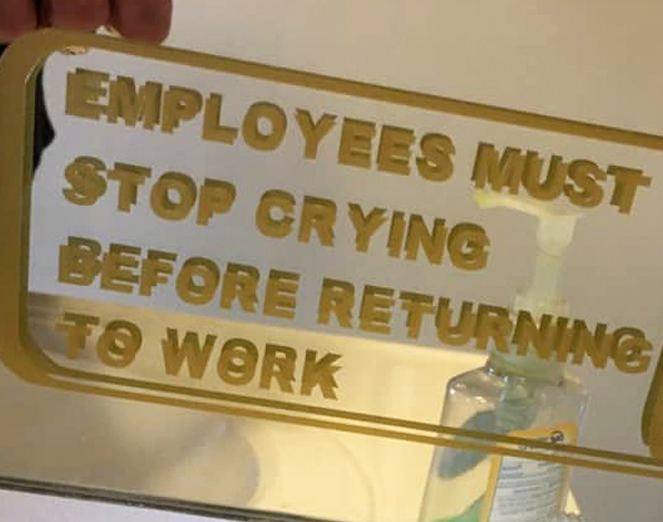Some of the charity is self-serving, e.g. eradicating diseases means he’s less likely to catch them (and really any billionaire not funnelling funds to pandemic prevention etc. is being moronic), and founding charter schools on land he owns so over the life of the school they pay more in rent for the lease than they cost to build is just a tax dodge. Most billionaires are just so evil that they won’t spend money on themselves if other people who aren’t paying also benefit, so in comparison, Gates’ better ability to judge what’s in his interests makes him look good.
AnyOldName3
- 0 Posts
- 267 Comments

 10·3 days ago
10·3 days agoThe main point of 32-bit Windows 10 wasn’t to make it run on non-64-bit hardware, it’s that x86 processors can’t run in 16-bit mode if they were booted in 64-bit mode, so if you’ve got an old 16-bit Windows/DOS/CPM app that you’ve absolutely got to run natively instead of through DOSBox and have to use modern Windows instead of an older version, it needs to be 32-bit. By the time Windows 11 released, Microsoft had decided that nearly no one still wanted to do that anymore.

 513·7 days ago
513·7 days agoAs it says in the article, it’ll be smaller and quieter, so less offensive for most people’s living rooms than a full-size desktop. It’s not meant to replace your existing PC if you have one, unless it was getting old and you were about to replace it anyway. If you don’t have a PC, or don’t have one in the living room, then it might be a better option than anyone else’s prebuilt.

 1·11 days ago
1·11 days agoThe original study was doctored, but plenty of others with similar results weren’t.

 1·11 days ago
1·11 days agoUsually when people post a source, the numbers say that at median screen sizes and distances from the screen, 4K isn’t perceptibly better than 1440p, and the person writing it up as an article has misunderstood the conclusion as saying 4K isn’t better than 1080p rather than that it isn’t better than 1440p. TVs tend not to be made with 1440p resolution, so upgrading from 1080p gets you right to 4K, skipping the sweet spot.

 14·11 days ago
14·11 days agoDrugs like Lecanemab don’t help in that they don’t reverse the progression of symptoms, but they do help in that they slow down the progression of symptoms. You’d expect someone who was given the drug for a few months to have more of their cognative ability left than someone who hadn’t had it, but they’d both be much worse than they were at the start.

 493·13 days ago
493·13 days agoIt’s still a luxury yacht decked out with nearly all the things you’d expect from a half a billion dollar superyacht. Only part of it is customised for research. If the main goal was to turn half a billion dollars into a research boat, this isn’t the boat that would get made.
They can’t figure out how to make themselves live forever, and as they’re the richest, they think they must be the cleverest, so anything they can’t think of is beyond the human mind and therefore they must create an artificial mind to solve it.

 2·20 days ago
2·20 days agoDrax often bids more for waste wood than the lumber industry would get for selling timber, so there’s already an incentive to declare any wood they can unsuitable. As long as there’s a way to get wood to Drax, the industry will find and exploit it.

 1·23 days ago
1·23 days agoInvestors have been happy to incentivise companies to hire idiot CEOs and managers who say the right buzzwords but reduce output by making bad decisions and only hiring people who don’t think they’re bad decisions, so an automated buzzword-dispensing idiot isn’t necessarily going to seem to investors like a downgrade compared to what they think most workers are. They’re just as likely to think AI lets them invest in companies where even the lowest tier employees are potential CEO material, and continue not noticing that the per-employee efficiency keeps going down. Data showing that layoffs nearly never pay for themselves doesn’t stop stock prices soaring whenever one happens, so I wouldn’t expect data showing AI makes companies less profitable to stop stock prices going up when a company announces a new dumb way they’ll use it.

 3·23 days ago
3·23 days agoThere was quite a lag between the variable-rate mortgage rates going up and everything noticeably exploding, so lots of people who were aware there was a real risk of things going tits up decided that it hadn’t and therefore wasn’t going to and had stopped looking for signs by the time they started to appear.

 71·24 days ago
71·24 days agoThe discussion on the talk page was basically nuh uh, loads of reputable sources like the Israeli and German governments say there’s no evidence of genocide, and even if they’re biased, anti-genocide NGOs are more biased because they have to accuse nations of genocide to justify their existence, with people responding to point out that’s not how Wikipedia’s rules work, and if it were, they’d have to rename the pages on various other genocides because there are very few that no nations deny.

 5·24 days ago
5·24 days agoIn principle, copyright law doesn’t stop there being a system that lets you redeem the same key from Steam, Epic and Gog as long as it’s the same person behind all three acounts. There’s already a degree of precedent for this - when a publisher generates Steam keys to sell at other retailers (whether they’re codes-in-a-box at a physical shop or an online retailer like Humble Bundle), they don’t have to pay Valve a fee, but the keys can be redeemed on Steam and work just like if you’d bought the game from the Steam store where Valve would take a 30% cut. Valve probably don’t think it’s in their interest to make libraries transferrable/sharable between Steam and not-Steam, but if they change their mind, and the competitors that they’re building the transfer/sharing system with also thought it was in their interests (which is unlikely to happen at the same time), there’s nothing stopping them building it.

 1·24 days ago
1·24 days agoIf you trust Adam Smith, an efficient market would quickly make new goods and services available for the lowest possible price. People are supposed to be incentivised to sell things, and competition is supposed to stop an excessive amount of money being diverted to profits instead of reinvestment and price cuts. There are supposed to be systems in place that ensure that there are always opportunities for competition, but the wealthiest have the most power to erode those mechanisms and the most interest in eroding them, and neoliberals think an Ayn Rand novel is the definitive text on how capitalism works rather than Adam Smith’s work, so even if you land in the capitalism makes everyone better off mode, it doesn’t last for long before it falls back into fuedalism with extra steps mode.

 4·26 days ago
4·26 days agoMagnets from Temu were probably just loose in a bag or some bubble wrap with no warning label. People should know they’re not food anyway, but defying a warning label wasn’t the particular flavour of dumbness exhibited here.

 3·26 days ago
3·26 days agoI don’t know if this is the same loophole used in NZ as in the UK and EU, but in the UK and EU, lots of things are banned from retail rather than completely illegal. If they’re imported and the importer sells them without demonstrating that they’re safe, the importer has committed a crime. If the importer keeps them for personal use, that’s fine, though. In theory, people ordering things from outside the EU and importing them are supposed to be aware that they’re importing things and that the stores aren’t necessarily only selling CE-marked goods, so they’re responsible for checking that they’re safe themselves, but in practice, people just see an online shop and don’t make a distinction from a domestic online shop except the price and delivery time. The EU is working on a law to close this loophole in some way.

 25·26 days ago
25·26 days agoPlanking was just lying down on things, so hardly an instance of teenagers endangering themselves.
The tide pod thing wasn’t exactly what it seemed to be. Some children with learning disabilities and some people with dementia had died from mistaking laundry pods for food. At some point, some media outlets decided to sensationalise it by leaving out the bit about learning disabilities. That meant that there were teenagers who thought other teenagers had died from eating them, so they could make videos pretending they’d done that, just like teenagers have staged videos to make it look like they’re doing dangerous things that they aren’t really doing ever since people have let them have cameras. Some of them decided that the easiest way to pretend was to put a real laundry pod in their mouth, pretend to chew it and swallow, pretend to die, and then cut the video and spit it out. If they checked the relevant warnings on the packet, they just said not to eat them and to rinse their eyes if they got any there, so this plan might seem safe. However, laundry pods are so corrosive against mucous membranes that putting one in your mouth and spitting it out immediately because it starts to burn immediately can still be fatal or cause permanent injury. The media reported the deaths and injuries as if teenagers were intentionally eating laundry pods, rather than pretending in a way the packet implied might be safe, so most people weren’t learning that pretending was also deadly and that the warnings on the packet weren’t exhaustive, so it just made fake tide pod challenge videos even more tempting. If the reporting had been more responsible, then most people would have first heard even pretending to eat laundry pods can kill rather than teenagers are eating laundry pods.

 3·30 days ago
3·30 days agoIt’s pretty obviously both things that were a problem. A mediocre prebuilt with a $200 premium over other mediocre prebuilts was unattractive, but plenty of people do buy overpriced mediocre prebuilts. The killer feature being that nearly no games were compatible was going to kill it even if the price was right, though.
Now we’re in the era of Proton, and games just work, if the price is fair, it’ll sell. If the price is you cannot get anything like this without spending much more like the Deck or how consoles used to be priced when the hardware made a loss and the profits came from games, then it’ll sell really well.

 102·1 month ago
102·1 month agoThere are a fair few troubleshooting things I’ve seen where I could have smugly pointed out a clever way Windows avoids the same problem or an easy way it provides to solve it, so it doesn’t even always need the lol at the end. It’s just an annoying thing to see when you’re already annoyed at a disobedient computer, unless learning the technical details would be an interesting distraction, so should be saved for when you know your audience and know it’s interesting.

I’ve printed kilos and kilos of Geeetech PLA, and that’s some of the cheapest on AliExpress (although I used to get it directly from their website before I realised doing that was normally more expensive). It arrives wet, but other than that, there’s (nearly) nothing to complain about (although years ago, I had a roll with two lumps of grit in it that caused clogs). I’ve had mixed success with their other materials - their ABS+ started burning in the nozzle while still being cold enough that layer adhesion was bad and their high-speed PLA has ridiculous oozing that causes ridiculous stringing, but their PETG and TPU seem fine. I’m pretty confident that their basic materials are absolutely worth £7/kg.